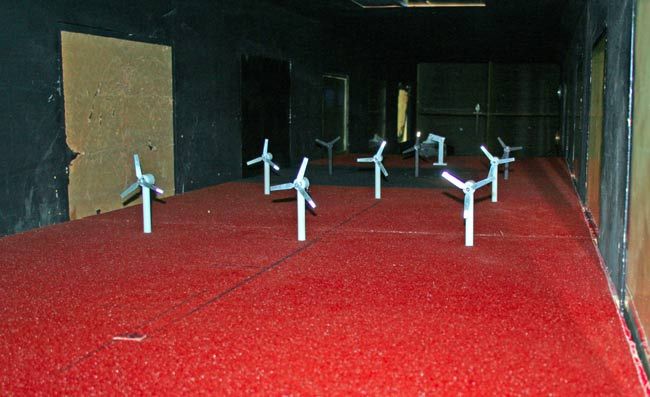Lab Tests Show Wind Turbine’s Air Flow

This Behind the Scenes article was provided to LiveScience in partnership with the National Science Foundation.
There are many massive, giant, man-made structures in real life that can be really hard to study in a "closed and controlled" environment. Structures such as bridges, skycrapers or planes to name a few. Amid the current energy crisis, our team working under the direction of Charles Meneveau, a turbulence expert at Johns Hopkins, and with colleagues at Rensselaer Polytechnic Institute, thought it would be interesting to understand the behavior of wind turbines. A dilemma then arises. How do we mimic the Earth’s atmosphere at that scale, but inside a wind-tunnel? Taking wind turbines that are on the order of 100 meters (109 yards) across and scaling them to a comfortable laboratory size of around 10 centimeters (4 inches) could be called a stretch. Placed in an array, as a wind farm, the turbines can turn out to be impressive to the human eye. To study these in a controlled manner from a fluid mechanics or turbulence science point of view, we used the concept of scalability. Recreating atmospheric flow At Johns Hopkins, we use the Stanley Corrsin wind tunnel to carry out experiments. After trial and error trying to recreate an atmospheric-like flow that suits and matches the one experienced daily by us humans — but now inside a 10 meter by 1 meter by 1.2 meter enclosure — we reached a practical solution. We manipulated the flow using rotating winglets to add random turbulence, long pieces of acrylic to recreate the wind conditions and sandpaper to imitate terrain. We carefully designed the experiments and after plenty of discussion, we decided that to do the job, we would create a 3-by-3 array of model wind turbines placed on top of a horizontal plate inside of the wind-tunnel, all submerged into the atmospheric-like flow will do the job. Goggles, fog like a rock concert To track the airflow, we use a laser-based technique frequently employed in fluid mechanics problems called Particle Image Velocimetry. The lasers have energy on the order of 120 mJ during a very short pulse, and a single beam can easily blind a person. Therefore, safety is strictly enforced in the lab and cool safety goggles are used. We created a laser sheet that illuminates tiny droplets created using a fog-machine that flow around the turbines. We took pictures to track the displacement of the particles, and this provided the information that we were interested in. We took measurements around the clock, and while we waited for the data to transfer to a hard-disk and for post-processing, the room where all the equipment sat looked like a massive rock concert venue with the green lights flashing and fog. Impact on current energy crisis After carrying out the measurements, the team members needed some time to build up stamina for the data analysis, which involved lengthy discussions and a flux of ideas. Perhaps the tiring feeling after a measurement campaign is not what keeps the team at Johns Hopkins motivated, but rather the understanding that the research carried out at the lab is pushing the boundaries of science, making an impact on current technologies and society during the current energy crisis. Our team hopes that this study will allow us to create better and more robust computer models that can represent the large structures and interactions between the periodic and turbulent motions created by a wind farm and the atmosphere. This will aid future wind farm designs, quantify their interactions with local wind conditions, and generate a better sense of how to use wind-power as a very promising, renewable source of energy.
- Video – Mysterious Airflow Around Wind Turbines
- Video – The Story of Wind Power
- 5 Myths About Wind Energy
Editor's Note: This research was supported by the National Science Foundation (NSF), the federal agency charged with funding basic research and education across all fields of science and engineering. See the Behind the Scenes Archive.
Sign up for the Live Science daily newsletter now
Get the world’s most fascinating discoveries delivered straight to your inbox.











